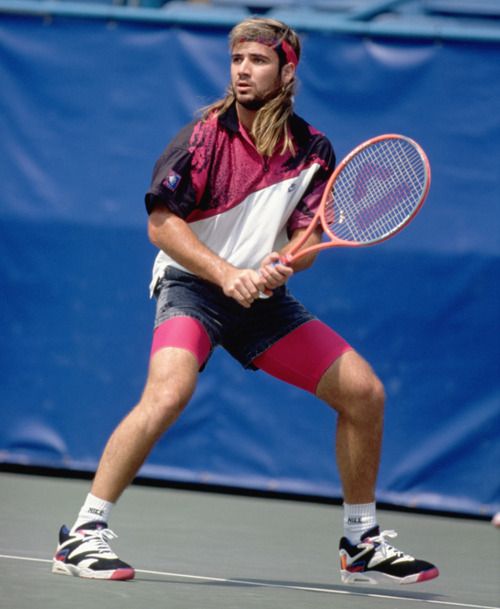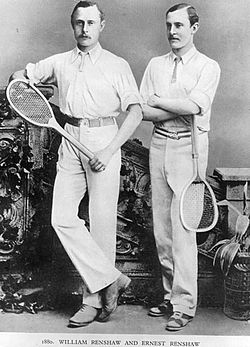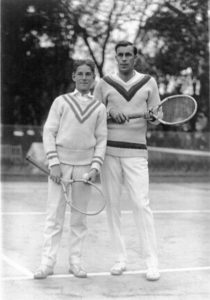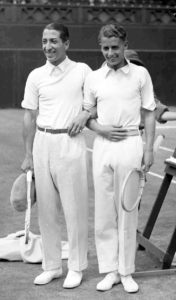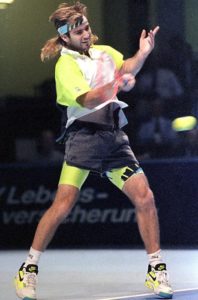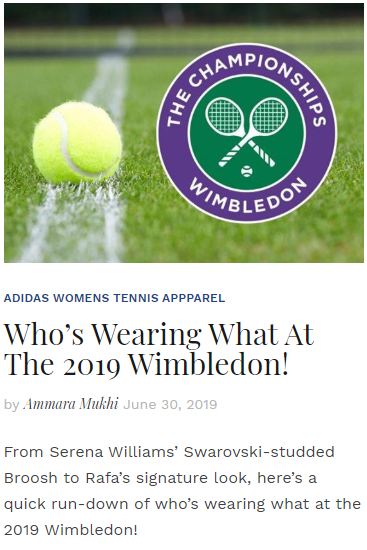In honor of Wimbledon, the most iconic major tournament in terms of fashion, let’s take a look at the history of tennis fashion and how it has changed over time. Just as mainstream fashions have evolved over the decades, tennis apparel has also changed due to advancements in technology, functionality, and popular trends. Although fashion and styles change, Wimbledon is one tournament that sticks to its traditional dress code.
Early Days
In the late 1800s and early 1900s tennis was strictly played in all-white apparel. Men wore trousers and dress shirts, while women were required to wear long dresses or skirts with long-sleeve tops. Wimbledon adopted the “tennis whites” clothing rule in 1890 and has since been keeping this tradition alive. White has both symbolic and functional reasons for being the color of choice. Symbolically it represents wealth and distinguishment. White also does a nice job hiding perspiration, which was frowned upon and deemed improper during that time period.
In the 1920s and 1930s uniforms started to change in style as well as material, but not in color. Colors were allowed to be used as trims, but the main color still had to be white. In the 1920s men wore wool and flannel slacks with sweaters similar to what players wore in cricket or croquet. Wool and flannel are great materials for absorbing sweat and keeping heat in, but not for moving around the court. Suzanne Lenglen was the first lady to break barriers in the 1920s when she wore short-sleeve or sleeveless tops with knee-length skirts and flapper-style headbands. This started a trend for women to wear shorter length skirts so they could have more mobility around the court. Helen Wills Moody also was a trend setter for women in the 1930s when she always wore sleeveless collared tops to play in. Men’s outfits started to change in the 1930s after Rene Lacoste created a lightweight, breathable cotton polo shirt with his now famous “Crocodile” brand. The men’s game made another change when Henry Austin wore the first tennis polo and shorts at the 1932 Wimbledon Championships.
Change of Era
In the 1940s and ‘50s, designer Ted Tinling, now known for his statement-making designs, changed the game by creating more feminine outfits for ladies on tour. Gertrude Moran worked with designer Tinling to create shorts and skirts that were shorter and more revealing. This allowed her to stand out amongst her competitors and start a new trend for women’s tennis apparel. While men still wore the classic polo or collared shirts, they also began wearing shorts that fell above the knee, allowing for better movement on court. The biggest rule change in tennis happened in 1972 at the US Open when players were allowed to include color in their uniform. Although this rule was implemented, most players still played in predominantly white outfits with some color.
Players like Bjorn Borg, John McEnroe and Vitas Gerulaitis started wearing more terrycloth clothing with colorful stripes and shorter shorts, which continued into the 1980s. The ‘80s saw a drastic difference in tennis fashion as apparel became tighter and more form fitting. Tracy Austin and Chris Evert made the most noise in fashion wearing colorful dresses that delighted spectators all around the world, while Anne White sparked major controversy at Wimbledon in 1985 after playing in an all-white unitard.
The 90s was another period of big change in men’s tennis fashion and it completely altered how we look at a “tennis” outfit. Andre Agassi was the star of this era wearing his classic rock and roll look on court. With his fluorescent shirts, jean shorts and brightly colored shoes this made him stick out everywhere he played. This also started the era of compression/spandex shorts for men to wear underneath their normal playing shorts. The women started seeing glimpses of the past come back into popularity, with mid-length skirts and short sleeved shirts, but with much more color. The only tournament with exception from these colorful outfits was Wimbledon.
2000s and Beyond
Two of the biggest influencers in women’s tennis fashion today are Venus and Serena Williams. They have made statements in fashion at almost every tournament starting in the late 90s. We have seen them wear many controversial outfits, but always within the limits of a tournament’s standard clothing regulations. One trait that Venus and Serena’s outfits tended to share was the type of material used. Polyester and Nylon are primarily used in this era because of their lightweight, durability, softness and sweat wicking benefits. Maria Sharapova is another major influencer in women’s tennis fashion today. She has made many different outfits over the years that have combined different fashion eras into one. One example is her 2008 Wimbledon “Tuxedo” outfit that included a blazer jacket for warm-ups, see-through tank top with a pleated front, and woven tennis shorts. With tennis having evolved in speed, agility and power, players needed outfits that could keep up with their new needs.
For men, the early 2000s went back to classic style with looser polo shirts and knee length shorts mostly made of cotton material. Although the game was growing faster, the men still liked the feel and softness of cotton. Roger Federer has continued the traditional tennis fashion by wearing classic polos and shorts, but with different fabrics, designs and colors. Over time, men’s apparel began to include polyester and nylon so players like Roger can play without worrying about sweat. Rafael Nadal has been a major influence in how we think about men’s tennis clothing today. When Rafa first started dominating the clay he wore “Capri” style shorts with no sleeve tees. This was out of the norm for men’s tennis and sometimes even questioned. However, he continued to wear this signature outfit in different colors and win tournaments. As time went on, he started wearing shorter shorts and tight short-sleeve t-shirts, bringing back the 1980s influence with updated fabrics as well as colors.
As you can see tennis apparel has evolved over time just like the sport itself. Players all around the world have found new and innovative ways to express their style on the court. But one thing that remains the same is the tradition and history that Wimbledon represents. It serves as a reminder of what separates tennis from every other sport. Shop for all the latest and greatest tennis apparel at Tennis Express today.
For More Apparel
Explore these blogs for additional apparel options:

